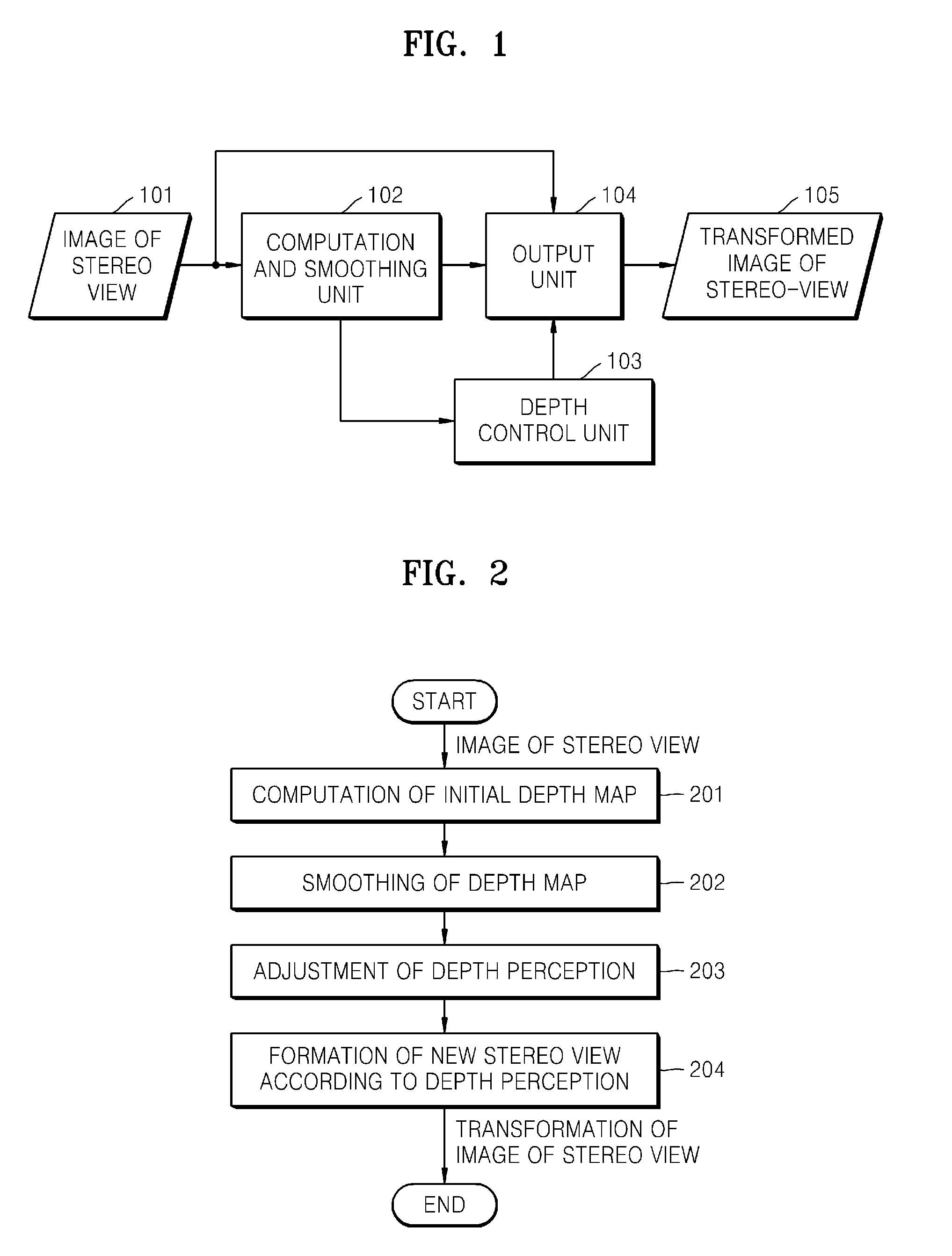[0010]Exemplary embodiments of the present general inventive concept provide a method of a
system to transform a stereo content to a decrease eye fatigue during viewing the 3D video images, including a calculating and
smoothing unit to calculate and smooth a
depth map, a
control unit to control a depth, and an output unit to visualize an image using the controlled depth where a first output of the calculating and
smoothing unit of a depth map is connected to a first input of the output unit, and a second output of the calculating and
smoothing unit of a depth map is connected to an input of the depth
control unit, and an output of the depth
control unit is connected to a second input of the output unit.
[0011]Exemplary embodiments of the present general inventive concept provide systems and methods computing a depth based on a stereo content, including surfaces with uniform sites (non-textured areas), depth discontinuity sites, on
occlusion sites and on sites with a repeating figure (template). That is, exemplary embodiments of the present general inventive concept provide systems and methods of determining set values of depth having increased reliability. Some values of depth, for example, for
occlusion (i.e. blocked) areas, do not yield to computation through matching, as these areas are visible only on one image. Exemplary embodiments of the present general inventive concept provide a synthesized, high-quality virtual view by determining a dense map, exacting borders of depth which coincide with borders of object, and leveling values of depth within the limits and / or boundaries of the object.
[0013]Exemplary embodiments of the present general inventive concept provide fast initial depth map refinement in a local window, instead of using a global method of optimization for a computation of disparity. The initial depth map can be received by methods of
local matching of stereo views. Usually, such kind of depth is very noisy, especially in areas with low texture and in the field of
occlusion. Exemplary embodiments of the present general inventive concept provide using a weighted
average filter to smooth an image and initial depth map refinement based on reference color images and reliable pixels of depth. Values of depth can be similar for pixels with similar colors in predetermined and / or selected positions or areas. Exemplary embodiments of the present general inventive concept can provide values of depth with increased reliability to uncertain pixels according to similarity of color and position in reference color images. The
filtration of the exemplary embodiments of the present general inventive concept can specify pixels with increased reliable depth and can form a dense and smooth depth map.
[0014]Exemplary embodiments of the present general inventive concept can provide systems and methods of determining whether a current pixel is abnormal (unreliable) or not. Unreliable pixels can be marked by one or more predetermined values of a
mask so that they may be detected and removed during
filtration. Exemplary embodiments of the present general inventive concept provide systems and methods of determining a reliability of a pixel, where cross-checking depth values can be applied at a left side and on a right side of an image. In other words, if the difference of values of depth at the left and on the right for corresponding points is less than a predetermined threshold value, the values of depth can be reliable. Otherwise, the values can be marked as abnormal and deleted from a smoothing method. However, filters with an increased
kernel size may increase the
efficacy in
processing abnormal pixels in cases of occlusion of object or noisiness of a depth map. Exemplary embodiments of the present general inventive concept can provide systems and methods of recursive realization to reduce the size of a kernel of the filter. As used throughout, recursive realization can be a result of
filtration that is saved in an initial buffer. Recursive realization can also increase a convergence speed of an
algorithm with a smaller number of iterations.
[0015]Exemplary embodiments of the present general inventive concept also provide systems and methods of detecting of abnormal pixels in a depth map by analysis of a plurality of pixels. To reduce and / or eliminate the noisiness of the raw depth map, an analysis of a
histogram can be applied. Values of noisiness of the depth map can be illustrated as
waves on low and high borders of the
histogram (see, e.g., FIG. 7). The
histogram can be modified and / or
cut on at least a portion of the borders of the histogram so as to remove abnormal pixels. Exemplary embodiments of the present general inventive concept can provide an apparatus and / or method of
cutting of the histogram, as well as that uses local histograms constructed according to predetermined and / or received information that can be stored in memory such that the whole image does not need to be processed.
[0016]Exemplary embodiments of the present general inventive concept can reduce and / or eliminate
noise of an initial depth map in sites with low texture by using at least one smoothing of depth method on such sites, where the method includes using stronger and / or increased settings of a
smoothing filter. A binary
mask of textured and low textured sites of the corresponding
color image can be formed, using at least one gradient filter. The filter can be a filtering method and / or filter apparatus to calculate a plurality (e.g., at least four types) of gradients in a local window.
 Login to View More
Login to View More  Login to View More
Login to View More 


